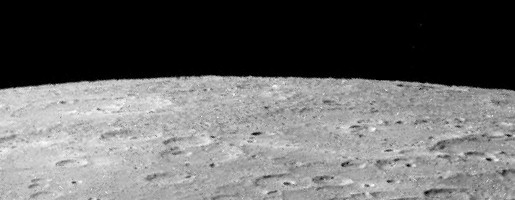 |
|
|
The surface of Mercury.
|
|
| THE SURFACE OF MERCURY | |
| Detailed studies of the surface of Mercury show there to be twelve different types of landscape or terrain on the planet; some associated with large structures, others associated with various epochs of volcanic activity. Distinguishing between them all is not always straightforward. | |
| There are however three particularly important terrain types, outlining three crucial stages in the evolution of Mercury. The three main types of landscape are heavily cratered terrain, intercrater plains and smooth plains. The heavily cratered plains are the oldest surface we can see and record the heavy bombardment by meteorites of the planet which took place 3.8 to 4.5 thousand million years ago. Some of the intercrater plains, produced by lava escaping from the interior of the planet and spreading out onto the surface may have formed at the same time. Most of these plains though, have fewer and smaller craters on them (5 to 10 kilometres in diameter), so probably formed just after heavy bombardment, about 3.5 to 3.8 thousand million years ago. Far less extensive are the smooth plains. Resembling lunar maria, the smooth dark regions or 'seas' of the Moon, they appear relatively featureless and dark. Close examination of the smooth plains shows lots of very small craters. | |
| However, we have only half the story, quite literally. The images obtained by Mariner 10 only cover about 45% of the surface, as on each of its passes, the same part of the planet was sunlit. What does the rest of Mercury look like? Though the images which were returned are generally considered to be characteristic of the planet as a whole, the other side could look very different. Radar measurements made from Earth show there to be little height variation on Mercury's unknown face. It might be that the dark side of Mercury is dominated by vast featureless lava plains. It will take another mission to see what is there, and to better understand how Mercury formed. | |
| Researchers are finding new ways to study the Mariner images. Recently, scientists studying the composition of materials on the surface have suggested that volcanic activity played a more important role in the history of Mercury than previously thought, operating for a longer time than first appeared. | |
| Craters | |
| Craters are certainly the most noticeable features on the surface of Mercury. At first glance they look much like lunar craters; but there are some important differences. The craters, like the ones on the Moon, were almost certainly produced by meteorites. They range in size from pits just 100 metres across (there are probably lots of even smaller ones) to huge basins over 1000 kilometres across. | |
| Mercury has many different styles of crater. Generally, small craters are simple in form and larger ones are more complicated - a trend that occurs throughout the Solar System. On Mercury craters under 20 kilometres across have the appearance of a circular bowl, above this size they have a raised rim and may have a knobbly hill in the middle called a central peak. Sometimes large craters have a ring of hills at their centre, either with or without a central peak. Parts of the inside rim of large craters sometimes collapse onto the smooth floor of the crater forming a set of concentric ridges or terraces. | |
| The different density of craters is sometimes used to estimate the age of the surface and the craters it contains. Another dating technique uses the state of preservation of a crater to determine its age relative to craters of comparable size. | |
| Older craters tend not to have rays associated with them and their rims appear rounded and hummocky because they have degraded over time. Craters are gradually worn down by countless tiny impacts disrupting the surface, turning the rock into a powdery soil. Gravity may cause parts of the crater rim to collapse, exploiting weaknesses in the rock. The rocks on Mercury may also be broken down by the extreme night and daytime temperature cycle: making the rocks expand and contract, eventually causing them to split and fall apart. | |
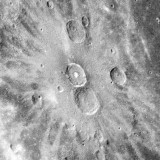 Younger craters have rims which appear sharp and well defined. Some craters, like Degas shown here, also have bright rays extending from their rims; this can show they are young because these streaks overlie all the surrounding surfaces. |
|
| The interiors of Mercury craters are very much like those on the Moon, particularly those located on the lunar maria. Differences are revealed only by detailed analysis of crater statistics. These show that the frequency of some crater properties varies slightly between the Moon and Mercury. Terraces, for example, are more common in Mercury craters which exceed 45 kilometres in diameter and that there are more fresh craters on Mercury with central peaks in 5 kilometres to 75 kilometres range. Such differences in the crater interiors are explained by variations in the target materials. The most visible differences, however, between lunar and Mercury craters is that the ejecta blanket, the material blasted outwards and landing beyond the rim of the crater, is confined to a smaller area than equivalent craters on the Moon. This is because the higher gravity on Mercury reduces the distance that the materials are able to travel. This also explains why on Mercury there is a higher density of secondary craters, the craters which are made by boulders ejected by the main impact. Many of these overlap or occur in lines, often so densely spaced that they merge together and form grooves in the surface. This pattern is quite different to that seen on the Moon where secondary craters are spread over a larger area. | |
 In addition to the smaller craters Mercury has numerous ringed craters, (left) as well as several multiple ring craters. |
|
| Ring and multi-ring craters are made by larger impacts generating shock waves so powerful that the surface behaves quite unlike rock; if we could see such a giant impact take place, the surface would appear to wobble. This wobble produces a series of rings, like a stone thrown into a pond. The ringed impact basins of Mercury, (Caloris and Tolstoy), are simply very large multi-ring craters. The relatively narrow spacing of the rings of those on Mercury compared to the ringed structures on the Moon and Mars indicate that the crust of Mercury at the time of the impact was quite thin. | |
| The lighting conditions of the Mariner images, combined with their poor preservation state means that some of the larger ringed craters are not easily seen. One of the largest craters on Mercury is Beethoven. Though 630 kilometres across, it is only apparent by a faint ring of cliffs. Beethoven illuminated from the side would dominate the landscape. Many large ringed craters are, however, quite easy to see. Bach (200 kilometres across) and Rodin (270 kilometres across) are well lit and have well defined topography. | |
| Caloris basin | |
| The Caloris basin is the largest structure on the surface of Mercury measuring 1,300 kilometres in diameter and is thought to have been produced by a huge impact. It is located near the sub-solar point (the point closest to the sun) at perihelion, and is so named for this reason (caloris is Latin for "heat"). | |
 Caloris basin. |
|
| Large impacts can produce multiple rings, as in this case. The outer ring is so prominent, rising 2 to 3 kilometres above its surroundings, that it is named Caloris Montes (mountains). Plains make up the interior of Caloris, these were formed when the rocks were melted by the collision, or by lavas deeper inside the planet getting to the surface through cracks made by the impact. The plains contain lots of criss-crossing fractures which formed when the molten rocks cooled down and contracted. Similar impact structures can be found on Jupiter's moon Callisto - namely the Asgard and Valhalla impact basins. Located at the antipodes (the opposite side of Mercury) to Caloris is a region comprising irregular and hummocky blocks and ridges. It is sometimes referred to as 'weird' terrain. | |
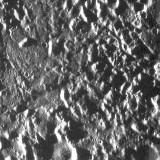 Caloris terrain. |
|
| This 'weird' terrain' is considered to have been formed by the shock waves generated by the Caloris impact, reverberating around the planet, deforming and uplifting blocks of surface materials when they met up at the other side. Similar antipodal terrains are seen on the Moon opposite the Imbrium and Orientale basins, which are also thought to have formed by massive impacts. | |
| Scarps and Ridges | |
| Although the landscape is dominated by craters and volcanic plains, a close look at Mercury shows numerous scarps and ridges. Scarps (dorsa) are produced by compression. Two segments of crust being forced directly together can slide either upward or downward along a fault plane creating a cliff. | |
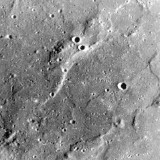 Mercury terrain. |
|
| Ridges (rupes), appear as narrow and irregular hills, 20 kilometres to 500 kilometres in length and up to 1000 metres in height, trailing across the plains of Mercury. They are the cause of much debate among planetary scientists trying to understand how the planet has evolved. Some have suggested that the ridges are related to stresses in the surface caused by the slowing down of Mercury's rate of spin. The poles are less flattened, and the equatorial region bulges outward less than they would if the planet was spinning faster. This change in the shape of the planet may have made the surface wrinkle up. The majority of researchers, however, favour the idea that the ridges were caused by the cooling of the planet. As the core of Mercury cooled and solidified it contracted, causing the surface to deform and buckle creating the irregular ridges we can see. | |
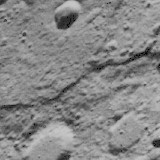 Mercury terrain. |
|
| Ice on Mercury | |
| Although it is impossible to observe detail on Mercury's surface using Earth-based telescopes, Mercury has been be studied from Earth using radar. Radar studies of Mercury's polar regions have detected about twenty areas of high radar reflectivity, possibly caused by deposits of ice. | |
| Given the high temperatures suffered by Mercury's surface, over 420oC , it would seem that Mercury is the last place we should look to find ice! However, the floors of craters within the polar regions are permanently in shadow, in which case temperatures are nearer -1700C, certainly cold enough for ice. But the question remains as to how the ice got there in the first place. Two possible sources are meteoritic/comet impact and surface outgassing. Meteorites may have carried water to Mercury which was then released during impact. Alternatively, there may be outgassing of water from Mercury's interior. Although most of the water would escape (due to the high temperatures and lack of a substantial atmosphere), any water that finds its way to the polar regions can become caught in Mercury's cold-traps. | |
| The existence of Mercurian ice is still only theoretical - ice has not been directly observed. Confirmation would have to come from a new spacecraft mission. The reflective areas are circular in shape, suggesting that ice may be located on the floors of craters. The largest ice area at the south pole coincides with the crater Chao Meng-Fu, shown here. | |
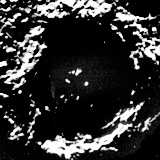 Chao Meng-Fu. |
|
|
|
|